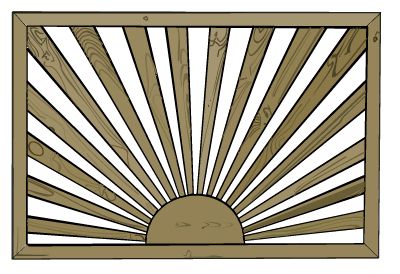
What is infill and where is it used?
The infill on your decking or pergola is the non-structural filling elements used to fill the empty spaces. This may include things like the materials used to fill the space between handrails, or lattice barriers put up to fence off one side of a pergola.
Infills can be used to mask an area that would detract from the scenery, to block out the wind or sun, to act as decoration or simply to provide a screen for privacy. A deck jutting out on slightly sloping ground, for instance, may have exposed supports and bracings underneath which may look unsightly. These could be hidden from view with infill.
What sorts of infills are available?
The most common type of infill is the balustrade, and the most common material for these is timber. The wood for balustrades should be straight with no flaws, and coated for weather protection. It can be incorporated into the handrail easily with a simple design - more complex designs may take a little more expertise, although in many cases prefabricated infills are widely available.
Another common choice for deck balustrades is stainless steel string, which has been swaged to special fittings to provide an almost solid barrier in between the railing and the deck. This allows for virtually uninterrupted views, in some cases more than glass can provide as it gives off no reflection.
Ultimately, your choice depends on the application for the infill. Wooden lattices can be used on pergolas to screen off one or more sides and can be used to train vines and creepers, providing a living shelter which will offer shade and regulate the temperature and airflow during summer. Shade cloth blinds can be used as temporary infills on pergolas to be pulled down when the sun is too harsh or the wind too strong for proper enjoyment.
What should I consider when choosing infills?
The first thing to consider should be any applicable building regulations to the choice of material you’re seeking to use and what types of infill might be required. You should also think of the aesthetics of the surroundings, your home and any other backyard features like gardens, ponds and trees. The purpose of the infill is important too - tensile steel wires won’t provide a lot of shade or privacy but will offer a stunning view. Consider what you want from your infill and don’t be afraid to think outside the box where regulations permit.
When are infills required for decking?
If your deck is higher than one metre off the ground, you will need some sort of fence or handrail with balustrades or infill, and if it is higher than four meters that fence will require vertical balustrades that comply with specific spacing requirements. Other requirements will apply too - depending on the material you're using and the spacing between your handrail posts, the infill you choose will need to be able to support a certain load and provide a given amount of weather resistance.
Your builder should be aware of these rules as they relate to your plans, and be able to advise you of what will comply.